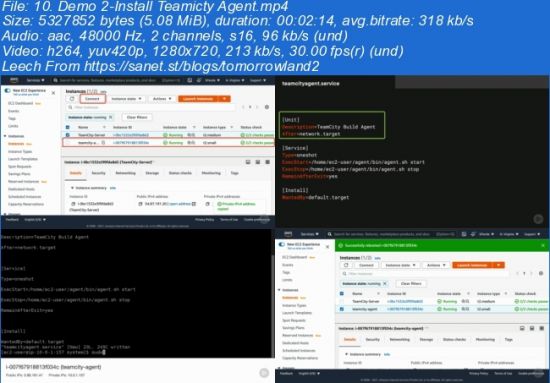
The checkout directory is configured in the Checkout Settings section on the Version Control Settings page the default Auto (recommended) value is strongly advised, but it is also possible to configure a custom checkout directory. The files are pulled into the build checkout directory. We can break down the steps required for us to deploy this application into a number of build steps. What location are the repo files pulled into on the agent? I have the repo connected via Version Control Settings already. A TeamCity configuration is made of build steps.

#Teamcity aws install
I will need to access the setup.py from my repository and then upload the the generated files. Install java 8 to install teamcity > sudo apt-get update > sudo apt-get install openjdk-8-jdk Check the java version > java -version Download the Teamcity Server, in our case we downloaded the latest version: 2020-2 > sudo wget > tar xfz TeamCity-For example, you could have a build configuration or build step to produce a docker image with python installed, then use the Docker Wrapper with this image in your command line step to run your python script.
#Teamcity aws software
TeamCity will make sure your software gets built, tested, and deployed, and will notify you on that the way you choose. TeamCity General Topics Integrating Amazon AWS CodeCommit with TeamCity Follow Ali Bolourian Created Aug13:02 Has anyone tried integrating CodeCommit git repository with TeamCity I tried both SSH and http based integration and it doesn't work either way (I get 403 errors). It takes moments to set up, shows your build results on-the-fly, and works out of the box. 4-5 years experience with AWS CI/CD Pipeline with strong experience in AWS CloudFormation. But I get this error: ' aws : The term aws is not recognized as the name of a cmdlet, function, script file' When I run the command in both cmd and powershell it works just fine.
#Teamcity aws windows
This would save you from having to rebuild and administer the agent every time. TeamCity is a continuous integration and delivery server from JetBrains (the makers of IntelliJ IDEA and ReSharper). Teamcity and AWS CLI 1 I am running Teamcity on a windows VM and have installed the awscli. If you go this far down the rabbit hole, you may also want to explore using the Docker Wrapper to run your commands within a specific docker image while the agent runs on the docker host or in another container with 'docker-in-docker'. While, the official build agent from jetbrains is great. improving our CI Jetbrains TeamCity plugin to detect unreliable tests, and moving two scala repos that were dependant on. The build agent is also a docker container that serves as an image for multiple on-demand build agents running on AWS. AWS Marketplace Seller Experiences team (worked remotely from Ottawa). First, download the plugin and install it on the TeamCity server. The plugin is compatible with TeamCity 2017.1.x and later. In addition to this, the new plugin for TeamCity, Amazon ECS Support, allows running Docker-based build agents in an EC2 Container Service cluster. For CI, we set up a standalone TeamCity server instance as a docker container for each client and deploy it to AWS. TeamCity has been able to run build agents on AWS EC2 instances for ages.


Then you could add an extra build configuration to automate it using the Docker Runner to build the image with the dockerfile. Continuous Integration (CI) with TeamCity and AWS. All I have left to do is to automatically publish those lambdas using TeamCity. For CI, we set up a standalone TeamCity server instance as a docker container for each client and deploy it to AWS. The newly created lambdas are all set, including the aws-lambda-tools.json. Continuous Integration (CI) with TeamCity and AWS.

It may be easier to use a dockerfile to make your image so you don't have to rebuild it by hand every time. AWS has the most secure, extensive, and reliable global infrastructure for running workloads that require high availability and is recognized as an industry leader for uptime standards. Net Core solution in which we just added. Well, you would need to do it anytime you wish to update the base image or make any changes to the environment. Unformatted template below with private info removed.Will I have to do this every time I update to the latest team city docker version?


 0 kommentar(er)
0 kommentar(er)
